|
|

Your download link is at the very bottom of the page... always. |
Processed through Paypal No account required. |
Buy our over-priced crap to help keep things running.

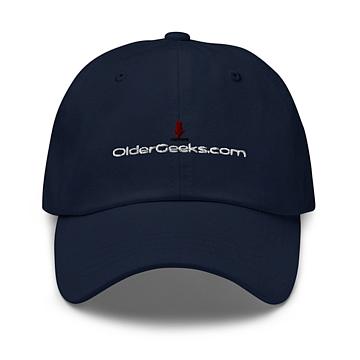








|
|

Your download link is at the very bottom of the page... always. |
Processed through Paypal No account required. |










| Files | ||||
| File Name | Rating | Downloads | ||
| AM-DeadLink v6.1 AM-DeadLink v6.1 Freeware to detect dead links and redirections. AM-DeadLink can check URLs for dead links and redirections from the following sources: • Text files • Tab delimited files • CSV files • HTML files • Google Chrome, Microsoft Edge, Firefox, Brave, Vivaldi Introduction AM-DeadLink provides an easy way to check various sources for dead links or redirections. AM-DeadLink will detect Browser bookmarks (and Browsers Applications) automatically, so no configuration should be required to check Browser bookmarks for dead links. How to check for dead links 1) Select Source Select the source from the dropdown box (eg. Google Chrome) 2) Check list Click the check button and wait until the check run has finished 3) Sort list Click the Sort button to move pages with errors to the top of the list (pages with errors are displayed in red and bold) How to delete bookmarks from your Browser 1) Open bookmark Open a bookmark via double click in your Browser and verify if it is no longer available. 2) Edit/Delete If a page is no longer available, then click "Edit/Delete" to open the selected bookmark in the bookmark manager of your browser. Right click the found result to edit or remove the bookmark. Dependent on the selected source, double clicking a bookmark will open the URL in the related browser window. That means, Chrome bookmarks will automatically open in Chrome, Edge bookmarks will open automatically in Edge, etc. Why bookmarks cannot be deleted directly in AM-DeadLink Browser bookmarks should only be deleted within the browser user interface, not via external tools. Changing ... |
 |
5,702 | Jan 30, 2025 Aignesberger Software GmbH 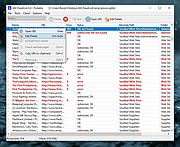 |
|
| BrowserAddonsView v1.25 BrowserAddonsView v1.25 BrowserAddonsView is a simple tool that displays the details of all Web browser addons/plugins installed in your system. BrowserAddonsView can scan and detect the addons of most popular Web browsers: Chrome, Firefox, and Internet Explorer. For Chrome and Firefox, BrowserAddonsView detects and scans all Web browser profiles if there are multiple profiles. System Requirements This utility works on any version of Windows, starting from Windows XP and up to Windows 10. Both 32-bit and 64-bit systems are supported. Known Issues When Firefox has more than one profile, the installed plugins will be displayed multiple times (one item for each profile), even if the plugins are linked to the same dll file. This download is for the 64bit version. If you need the 32bit version, download here. Versions History Version 1.25: You can now use any variable inside BrowserAddonsView.cfg as command-line option in order to load the BrowserAddonsView tool with the desired configuration. For example, the following command will load the Web browser addons from the remote computer - 192.168.0.40 : BrowserAddonsView.exe /DataSourceMode 4 /RemoteComputer 192.168.0.40 Start Using BrowserAddonsView BrowserAddonsView doesn't require any installation process or additional DLL files. In order to start using it, simply run the executable file - BrowserAddonsView.exe After running BrowserAddonsView, the main window displays the list of all addons found on your system. You can select one or more addon items, and export the addons list to text/csv/tab-delimited/xml/html file using the 'Save Selected Items' option, or copy the addons list to the clipboard (Ctrl+C) and paste it to Excel or any other spreadsheet application. Viewing the addons list from remote system or external drive BrowserAddonsView also allows you to view the addons list of Firefox and Chrome Web browsers from a remote computer on your network and from external disk plugged ... |
 |
5,634 | Jan 16, 2021 Nir Sofer  |
|
| BrowserDownloadsView v1.41 BrowserDownloadsView v1.41 A tool for Windows that displays the details of downloaded files of Chrome and Firefox Web browsers. BrowserDownloadsView is a tool for Windows that displays the details of downloaded files of Chrome and Firefox Web browsers. For every download, the following information is displayed: Filename, Download URL, Web Page URL, Start Time, End Time, Download Duration, Download Size, Web Browser, and more... BrowserDownloadsView allows you to load the downloads list from your current running system (your user or all user profiles), from remote computer on your network , and from external hard drive. After BrowserDownloadsView loads the downloads list, you can select one or more downloads and then export them to comma-delimited/tab-delimited/html5/xml/JSON file or calculate the MD5/SHA1/SHA256/SHA512 hash of the downloaded files. System Requirements This tool works on any version of Windows, starting from Windows XP and up to Windows 11. Both 32-bit and 64-bit system are supported. It works with Chrome, Firefox, and other Web browsers based on these Web browsers (SeaMonkey, Opera, Yandex, Vivaldi, Brave, Chromium-Based Edge). It doesn't show the files downloaded when the Web browser was in private mode, because in private mode the details of downloaded files are not saved to the database. Changes: Version 1.41 Explorer context menu inside BrowserDownloadsView: When you right-click on a single item while holding down the shift key, BrowserDownloadsView now displays the context menu of Windows Explorer, instead of the BrowserDownloadsView context menu. This feature only works for existing downloaded files. Start Using BrowserDownloadsView BrowserDownloadsView doesn't require any installation process or additional DLL files. In order to start using it, simply run the executable file - BrowserDownloadsView.exe After running BrowserDownloadsView, it loads the list of downloads from your Firefox and Chrome Web browsers and displays it in the main window. If you want to view the Web browser downloads from other ... |
 |
3,948 | Apr 07, 2022 Nir Sofer  |
|
| Browserosaurus v20.11.0 Browserosaurus v20.11.0 A browser prompter for macOS Browserosaurus is an open-source (GPLv3 license), browser prompter for macOS. It works by setting itself as the default browser; any clicked links in non-browser apps are now sent to Browserosaurus where you are presented with a menu of all your installed browsers. You may now decide which app you’d like to continue opening the link with. Changes: v20.8.0 feat: add support for PrivateWindow and PublicWindow browser apps by @skgreg in #705 feat: add support for Zen and Twilight (Zen Beta) by @typeofweb in #706 This download is for the macOS Apple Silicone version (very bottom of page). If you need the macOS Intel version, download here. Click here to visit the author's website. |
 |
1,874 | May 27, 2025 Will Stone  |
|
| ChromeCacheView v2.52 ChromeCacheView v2.52 Free cache viewer for the Google Chrome web browser. ChromeCacheView is a small utility that reads the cache folder of Google Chrome Web browser, and displays the list of all files currently stored in the cache. For each cache file, the following information is displayed: URL, Content type, File size, Last accessed time, Expiration time, Server name, Server response, and more. You can easily select one or more items from the cache list, and then extract the files to another folder, or copy the URLs list to the clipboard. Supported operating systems: Windows 2K/XP/7/8//10/11 Using ChromeCacheView ChromeCacheView doesn't require any installation process or additional DLL files. Simply copy the executable file (ChromeCacheView.exe) to any folder you like, and run it. After you run it, the main window displays the list of files currently stored in the cache of the default Google Chrome user. You can select one or more cache files from the list, and then export the list into text/html/xml file ('Save Selected Items' option), copy the URL list to the clipboard (Ctrl+U), copy the entire table of cache files (Ctrl+C), and then paste it to Excel or to OpenOffice spreadsheet. You can also extract the actual files from the cache, and save them into another folder, You can do that by using the 'Copy Selected Cache Files To' option (F4). Starting from version 2.10 - When you select image cache item ( gif, png, jpg) or text-based cache item (HTML, CSS, JSON, Javascript), you can watch the content of the cache file in the lower pane if the 'Show Preview Pane' option is turned on (View -> Show Preview Pane or simply press F8). Changes: v2.52 Updated to read the HTTP headers properly in the latest versions of Chrome (Version 132). License This utility is released as freeware. You are allowed to freely distribute ... |
 |
9,068 | Feb 23, 2025 Nir Sofer  |
|
| ChromeCookiesView v1.74 ChromeCookiesView v1.74 An alternative to the standard internal cookies viewer of Google Chrome Web browser. It displays the list of all cookies stored by Google Chrome Web browser, and allows you to easily delete unwanted cookies. It also allows you export the cookies into text/csv/html/xml file. For every cookie, the following information is displayed: Host Name, Path, Name, Value, Secure (Yes/No), HTTP Only Cookie (Yes/No), Last Accessed Time, Creation Time, Expiration Time. System Requirements This utility works on any version of Windows, starting from Windows 2000 and up to Windows 11, and with any version of Google Chrome. Changes: Version 1.74: Fixed a problem with decrypting cookies from external drive on Windows 11 22H2 Using ChromeCookiesView ChromeCookiesView doesn't require any installation process or additional DLL files. In order to start using it, simply run the executable file - ChromeCookiesView.exe The main window of ChromeCookiesView displays the list of all cookies stored in your Google Chrome Web browser. You can select one or more chookie entries, and then use the 'Delete Selected Cookies' (Ctrl+Del) to delete them. If you want to view the cookies stored in another cookies file, go to 'Advanced Options' window (F9) and choose the desired cookies file. Command-Line Options /DeleteCookies <Host> {Cookie Name} Deletes cookies from command-line. If you specify only the host name, all cookies of this host name will be deleted. If you also specify the cookie name, only this specific cookie will be deleted. Examples: ChromeCookiesView.exe /DeleteCookies ".amazon.com" ChromeCookiesView.exe /DeleteCookies ".amazon.com" "session-token" /DeleteCookiesWildcard <Host Wildcard> {Cookie Name Wildcard} Similar to /DeleteCookies, but it also allows you to specify the host name and cookie name as wildcard. For example, if you specify "*.google.com", all google.com cookies will be deleted (including www.google.com, accounts.google.com, and so on) Examples: ChromeCookiesView.exe /DeleteCookiesWildcard "*.google.com" ChromeCookiesView.exe /DeleteCookiesWildcard "*.amazon.*" "session*" /CookiesFile <Filename> Specifies the cookies file to load from command-line, for example: ChromeCookiesView.exe /CookiesFile "c:\temp\Chrome\cookies" /stext <Filename> ... |
 |
3,142 | Dec 28, 2023 Nir Sofer 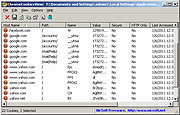 |
|
| ChromeHistoryView v1.53 ChromeHistoryView v1.53 A small utility that reads the history data file of Google Chrome Web browser, and displays the list of all visited Web pages in the last days. For each visited Web page, the following information is displayed: URL, Title, Visit Date/Time, Number of visits, number of times that the user typed this address (Typed Count), Referrer, and Visit ID. You can select one or more history items, and them export them into html/xml/csv/text file, or copy the information to the clipboard and paste it into Excel. You can also use this tool to read the history of other Chromium-based Web browsers, like Microsoft Edge, Opera, Vivaldi, and others... Changes: Version 1.53 Updated to read the history file of the latest Opera versions. Using ChromeHistoryView ChromeHistoryView doesn't require any installation process or additional DLL files. In order ti start using it, simply copy the executable file (ChromeHistoryView.exe) to any folder you like, and run it. After you run it, the main window displays the list of visited Web pages loaded from the history file of Chrome Web browser. If you want to load the history file of another profile, simply use the Advanced Options window (F9) to choose another history file. You can select one or more history items, and then export the list into html/xml/csv/text file ('Save Selected Items' option - Ctrl+S). You can also copy the selected items to the clipboard, and then paste them to Excel or to OpenOffice spreadsheet. Command-Line Options /stext <Filename> Save the Chrome browsing history into a regular text file. /stab <Filename> Save the Chrome browsing history into a tab-delimited text file. /scomma <Filename> Save the Chrome browsing history into a comma-delimited text file (csv). /stabular <Filename> Save the Chrome browsing history into a tabular text file. /shtml <Filename> Save the Chrome browsing history into HTML file (Horizontal). /sverhtml <Filename> Save ... |
 |
5,717 | Mar 18, 2024 Nir Sofer  |
|
| Classic Theme Restorer for Firefox 1.6.4 Classic Theme Restorer for Firefox 1.6.4 The Classic Theme Restorer (Customize UI) for Firefox web browsers will restore the classic look and feel of Firefox 29 or earlier. This add-on restores squared tabs, the application button with application menu (known from Firefox for Windows), the add-on bar, bookmarks/history menu/sidebar buttons and other buttons. It moves star & feed buttons into location bar, adds status bar element to the ui and allows many items to be movable. All features are fully optional. Some buttons have to be moved to toolbars manually using browsers 'customizing' mode. Main features (on CTRs preferences window) Tab appearance: squared tabs (classic) Tab appearance: curved tabs (all colored and visible) Tabs not on top + [tabsontop="false/true"] attribute Tab width and height settings Tab title in Firefox titlebar Tab loading animations Tab close button on all tabs, active tab, toolbars start/end Restore tabs empty favicon Custom 'new tab' page url (Firefox 41+) Double click on tabs toolbar opens 'new' tab [Windows only] Hide tabs toolbar with one visible tab Custom colors for tab backgrounds, text and text shadow Custom tab separators Application button on toolbars (+ icon variations) Application button on titlebar [Windows only] Custom title for application button on titlebar [Windows only] Predefined/custom application button colors Small navigation toolbar buttons Movable back-forward buttons Alternative appearance for preferences/options page Open preferences/options page in a window (simulates preference window) Alternative add-ons manager appearance (Firefox 40+) ... |
 |
7,015 | Apr 20, 2017 Aris 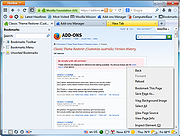 |
|
| EdgeCookiesView v1.17 EdgeCookiesView v1.17 EdgeCookiesView is a tool for Windows that displays the cookies stored by newer versions of Microsoft Edge Web browser and IE11 (Starting from Fall Creators Update 1709 of Windows 10). It also allows you to select one or more cookies and then export them to tab-delimited, csv file, html file, or to a file in cookies.txt format. You can read the cookies from the current running system or from the WebCacheV01.dat database on external hard drive. Notice: The new version of Edge is now based on Chromium, so you can use the ChromeCookiesView tool to view the cookies of this new Edge Web browser. EdgeCookiesView vs IECookiesView IECookiesView is very old tool originally developed in 2002 (!) and it still works with earlier versions of Edge Web browser that store the cookies in text files, exactly like Internet Explorer. But starting from Fall Creators Update 1709 of Windows 10, the cookies of Microsoft Edge Web browser are stored in the WebCacheV01.dat database together with the history and cache information, so IECookiesView cannot read the cookies of Edge anymore. EdgeCookiesView is a new tool designed to read the cookies from the WebCacheV01.dat database. Versions History Version 1.17: Added 'Add Remark Line To cookies.txt' option. When it's turned on, '# Netscape HTTP Cookie File' header line is added to cookies.txt file format. Start Using EdgeCookiesView This utility doesn't require any installation process or additional DLL files. In order to start using it, simply run the executable file - EdgeCookiesView.exe After running EdgeCookiesView, the main window displays the cookies stored by Microsoft Edge Web browser (Assuming that you have Fall Creators Update 1709 of Windows 10 or later updates). If you want to view the cookies from external system, open the 'Advanced Options' window (F9), choose the 'External database file' option and then select ... |
 |
5,216 | Apr 04, 2021 Nir Sofer 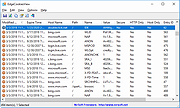 |
|
| Firefox Download Tool v1.5.0.23 Firefox Download Tool v1.5.0.23 The Firefox Download Tool is used for downloading different versions and language variants of the Firefox Internet browser. By default, the software always downloads the most recent version; however, selecting older versions versions is possible as well. Furthermore, the tool can be used for selecting the language variant of Firefox and deciding between the 32-bit and the 64-bit version. Information related to the selected Firefox version is displayed in the lower part of the window. Download is started by pushing the Start button. The progress bar provides information about the state of the downloading process. If the download is successfully completed, the Firefox installation file appears in the indicated directory. The text in the lower part of the window becomes active and turns blue. It can be used for initiating the installation of the downloaded file. The Copy function displayed below the progress bar is used for copying the following information related to the downloaded file onto the clipboard: 1) Information related to the Firefox version: version ID, language, 32-bit or 64-bit 2) The file name and path 3) The download URL 4) The MD5, SHA1 and SHA256 information required for checking the integrity of the download The text 'VirusTotal' used for directly checking the downloaded file for virus protection. This function works properly only if the related file has already been added to the Virus Total database. If the file in question has never been checked before, it can be uploaded for free at any time. After the file is uploaded, the Firefox Download Tool will load the appropriate Virus Total page. The program is free to download and use. It supports Windows 7/8/10 operating systems. MD5: 44f8b5f1a6d6cefa3c695479ad9904af Version: 1.5.0.23 - Date: 2019-09-06 Add: Check running Firefox before install ... |
 |
5,449 | Sep 19, 2019 WinTools  |
|
| Firefox Environment Backup Extension (FEBE) 8.9.3.1 Firefox Environment Backup Extension (FEBE) 8.9.3.1 FEBE allows you to quickly and easily backup your Firefox extensions. In fact, it goes beyond just backing up -- It will actually rebuild your extensions individually into installable .xpi files. Now you can easily synchronize your office and home browsers. FEBE backs up and restores your extensions, themes, and (optionally) your bookmarks, preferences, cookies. and much more. Backup as little or as much of your Firefox environment as you wish. Perform backups on demand or schedule daily, weekly, or monthly unattended runs. Sequential backups can be stored in timestamped directories so you can restore back as far as you like. You may specify "User-defined" items to have FEBE backup Thunderbird, Greasemonkey scripts, or virtually any data on your computer - Firefox related or not. Version history (FEBE 8.0) November 11, 2016: Version 8.9.3.1 (1,375 kb) Fix for browser history restore. For Firefox v49.0 - v51.0a2 |
 |
6,825 | Aug 01, 2017 Chuck Baker 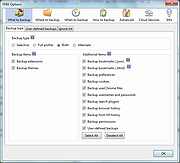 |
|
| Firemin v11.8.3.8398 Firemin v11.8.3.8398 A small utility to reduce the amount of memory Firefox or other browsers use. Having Firefox memory issues? Is it using over 1GB of your precious computer memory? Download Firemin and control the amount of memory Firefox uses. Firemin works with Google Chrome, Opera, Brave, Palemoon, or any other executable. From the author: Although Firefox memory usage improved a little over the last few years, it still uses a lot of memory; a little more than we feel comfortable with. Programs on my computer can stay open and run for days or even weeks, and Firefox is no exception. Because of this Firefox was using over 3 GB of memory after a few days. It’s quite normal for Firefox to be sucking up over 250 MB of memory right off the bat. In a memory leak, you’ll see the memory usage keeps increasing the longer the program is open/in use and this is exactly what happens with Firefox. Simply put, Firemin will attempt to eliminate Firefox memory leaks and decrease the amount of memory Firefox uses. All I did was tweak our Memory Booster a little and applied it to Firefox and this solved the memory leak issues. Using Firemin Select your browser Firemin will work with any browser, in fact, it will work with any program. For example, to configure it for Firefox; on the main Firemin screen, press the Browse button and navigate to the Firefox directory (normally C:\Program Files\Mozilla Firefox) and select the Firefox.exe executable. Press the Save button to store the setting. Configuring Firemin Still on the main screen; set Firemin to Reduce memory every 500 milliseconds. Although 1000 is the default here, we found that sometimes a lower setting yield better results. Play around with this setting to find your ideal configuration. The Only reduce memory if usage over x setting allows you ... |
 |
5,512 | Nov 01, 2023 Rizonesoft 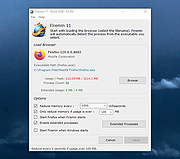 |
|
| Flagfox 5.0.15 Flagfox 5.0.15 Flagfox is an extension that displays a flag icon indicating the current webserver's physical location. Knowing where you're connected to adds an extra layer of awareness to your browsing and can be useful to indicate the native languages and legal jurisdictions that may apply. Additional information can be obtained via a multitude of external lookups and users can add their own custom actions. All actions can be added to the flag icon's context menu and set to icon click or keyboard shortcuts for quick access. Clicking the flag icon loads our default action, Geotool, which gives a detailed map showing the city the server is in and other useful information such as its local time and ISP. Features: Site safety and malware checks Finding similar sites and reviews Automatic translation to your language SEO and web development research Diagnostics like pings and traceroutes Whois and DNS information Page code validation Quick URL shortening Copying a server's IP address or other info, or you can create your own custom actions! Changelog: Version 5.0.15 — May 11, 2015 — 724 KB * IPv4 & IPv6 address location database updates for May 2015 * Updated many actions to use HTTPS now that they support it * Minor flag icon set update |
 |
8,712 | May 12, 2015 Flagfox 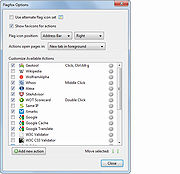 |
|
| Greasemonkey v4.9 Greasemonkey v4.9 Greasemonkey Firefox addon allows users to install scripts that make on-the-fly changes to web page content after or before the page is loaded in the browser (also known as augmented browsing). Customize the way a web page displays or behaves, by using small bits of JavaScript. The changes made to the web pages are executed every time the page is viewed, making them effectively permanent for the user running the script. Greasemonkey can be used for customizing page appearance, adding new functions to web pages (for example, embedding price comparisons within shopping sites), fixing rendering bugs, combining data from multiple web pages, and numerous other purposes. With Greasemonkey you can write your own scripts or choose from the many scripts that already exist. Changelog: Version 4.9 Released Jun 12, 2019 - 529.75 KB Works with firefox 57.0 and later, android 57.0 and later Bug fixes: * Error handling scripts with certain names (bug added in v4.8). (#3035) Click here to visit the author's website. |
 |
6,544 | Jan 22, 2020 Aaron Boodman 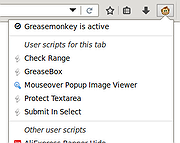 |
|
| ImageCacheViewer v1.27 ImageCacheViewer v1.27 A simple tool that scans the cache of your Web browser (Internet Explorer, Firefox, or Chrome), and lists the images displayed in the Web sites that you recently visited. System Requirements And Limitations This utility works in any version of Windows, starting from Windows XP and up to Windows 10. Both 32-bit and 64-bit systems are supported. The following Web browsers are supported: Internet Explorer, Mozilla Firefox, SeaMonkey, and Google Chrome. ImageCacheViewer won't work if you configure your Web browser to clear the cache after closing it. It's recommended to close all windows of your Web browser before using ImageCacheViewer, to ensure that all cache files are saved to the disk. Start Using ImageCacheViewer ImageCacheViewer doesn't require any installation process or additional DLL files. In order to start using it, simply run the executable file - ImageCacheViewer.exe After running ImageCacheViewer, it begins to scan the cache of your Web browser, and displays all cached images from Web sites you visited in the last day. If you want to get images from other days, you can remove or change the last 1-day filter from the 'Advanced Options' window (F9). After the scanning process is finished, you can also watch the image in the lower pane of ImageCacheViewer, by selecting the desired item in the upper pane. If from some reason ImageCacheViewer fails to detect the cache of your Web browser properly, you can go to 'Advanced Options' window (F9), and choose the desired cache folders to scan for each Web browser. Command-Line Options /stext <Filename> Save the cached images list into a simple text file. /stab <Filename> Save the cached images list into a tab-delimited text file. /scomma <Filename> Save the cached images list into a comma-delimited text file (csv). /stabular <Filename> Save the cached ... |
 |
5,140 | Jan 18, 2022 Nir Sofer 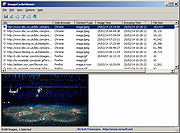 |
|
| Lightbeam for Firefox 1.0.8 Lightbeam for Firefox 1.0.8 A Firefox add-on that enables you to see the first and third party sites you interact with on the Web. Using interactive visualizations, Lightbeam shows you the relationships between these third parties and the sites you visit. Using three distinct interactive graphic representations — Graph, Clock and List — Lightbeam enables you to examine individual third parties over time and space, identify where they connect to your online activity and provides ways for you to engage with this unique view of the Web. When you activate Lightbeam and visit a website, sometimes called the first party, the add-on creates a real time visualization of all the third parties that are active on that page. The default visualization is called the Graph view. As you then browse to a second site, the add-on highlights the third parties that are also active there and shows which third parties have seen you at both sites. The visualization grows with every site you visit and every request made from your browser. In addition to the Graph view, you can also see your data in a Clock view to examine connections over a 24-hour period or in a List view to drill down into individual sites. Limitations: Works with Firefox 19.0 and later |
 |
8,431 | Mar 03, 2014 Mozilla |
|
| MSEdgeRedirect v0.7.3.0 MSEdgeRedirect v0.7.3.0 A Tool to Redirect News, Search, Widgets, Weather and More to Your Default Browser. This tool filters and passes the command line arguments of Microsoft Edge processes into your default browser instead of hooking into the microsoft-edge: handler, this should provide resiliency against future changes. Additionally, an Image File Execution Options mode is available to operate similarly to the Old EdgeDeflector. Additional modes are planned for future versions. No Default App walkthrough or other steps, just set and forget. System Requirements Minimum Requirements OS: Windows 8.1 CPU: 32-bit Single Core RAM (Memory): 40MB Free Disk (Storage): 5MB Free Recommended Requirements OS: Latest Windows 11 Build CPU: 64-bit Dual Core or Higher RAM (Memory): 100MB Free Disk (Storage): 100MB Free Click here to visit the author's website. |
 |
1,321 | Jun 06, 2023 Robert C. Maehl 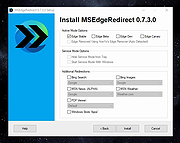 |
|
| MZCacheView v2.22 MZCacheView v2.22 Free tool to view the cache files of Firefox Web browsers. MZCacheView is a small utility that reads the cache folder of Firefox/Mozilla/Netscape Web browsers, and displays the list of all files currently stored in the cache. For each cache file, the following information is displayed: URL, Content type, File size, Last modified time, Last fetched time, Expiration time, Fetch count, Server name, and more. You can easily select one or more items from the cache list, and then extract the files to another folder, or copy the URLs list to the clipboard. Supported operating systems: Windows 98 through Windows 11 Changes: v2.22 You can now use any variable inside the .cfg file as command-line option in order to change the configuration from command-line, for example - this command turns on the 'Add Header Line To CSV/Tab-Delimited File' option: MZCacheView.exe /AddExportHeaderLine 1 Using MZCacheView MZCacheView doesn't require any installation process or additional DLL files. Just copy the executable file (MozillaCacheView.exe) to any folder you like, and run it. After you run it, the main window displays the list of files currently stored in the cache of the Mozilla/Firefox profile that you used in the last time. If you want to view the cache of another profile, simply use the 'Select Cache Folder' option (F9), and choose the desired cache folder. You can select one or more cache files from the list, and than export the list into text/html/xml file ('Save Selected Items' option), copy the URL list to the clipboard (Ctrl+U), copy the entire table of cache files (Ctrl+C), and then paste it to Excel or to OpenOffice spreadsheet. You can also extract the actual files from the cache, and save them into another folder, You can do that by using the 'Copy Selected Cache Files To' option (F4). Notice: In order to ... |
 |
9,042 | Feb 23, 2025 Nir Sofer 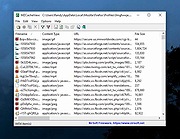 |
|
| MZCookiesView v1.60 MZCookiesView v1.60 Free cookies manager for Firefox web browsers. MZCookiesView is an alternative to the standard 'Cookie Manager' provided by Firefox and Mozilla browsers. It displays the details of all cookies stored inside the cookies file (cookies.txt or cookies.sqlite) in one table, and allows you to save the cookies list into text, HTML or XML file, delete unwanted cookies, and backup/restore the cookies file. Supported operating systems: MZCookiesView works properly in all versions of Windows, including Windows 11. If you have 64-bit version of Firefox, you should use the 64-bit version of MZCookiesView, because MZCookiesView uses the SQLite library of Firefox installation to read the cookies SQLite database (cookies.sqlite) Changes: v1.60 Updated to keep the scroll position after refresh and after deleting cookies Using MZCookiesView MZCookiesView doesn't require any installation process or additional DLLs. In order to start using it, just copy the executable (mzcv.exe) to any folder you like, and run it. If you have an advanced version of Mozilla or Netscape browsers, MZCookiesView automatically locates your cookies file and displays the list of all cookies stored in there. If you have more than one profile in your browser, you can view the cookies of other profiles by using the 'Select User Profile' option. If MZCookiesView fails to automatically find your cookies file, you can still select the cookies file manually, by using the 'Select Cookies File / Folder' option. In the main window of MZCookiesView, you can easily select one or more cookies, and then delete them, copy the cookies information to the clipboard, or save them to text, HTML, or XML file. License This utility is released as freeware for personal and non-commercial use. You are allowed to freely distribute this utility via floppy disk, CD-ROM, Internet, or in any other way, as long as you don't charge anything for this. If you distribute this ... |
 |
8,844 | Feb 23, 2025 |
|
| MZHistoryView v1.70 MZHistoryView v1.70 Free history viewer for Firefox and Mozilla-based browsers. MZHistoryView is a small utility that reads the history data file (places.sqlite or history.dat) of Firefox/Mozilla/Netscape Web browsers, and displays the list of all visited Web pages in the last days. For each visited Web page, the following information is displayed: URL, First visit date, Last visit date, Visit counter, Referrer, Title, and Host name. You can also easily export the history data to text/HTML/Xml file. Supported operating systems: Windows 98 through Windows 11. Changes: v1.70 MZHistoryView now reads the history database of Firefox directly without using the SQLite library from the install folder of Firefox. It means that you can now use this tool even if Firefox is not installed on your system, as long as you have the places.sqlite database file. You can now send the data to stdout by specifying empty string as filename, for example: MZHistoryView.exe /scomma "" | more Using MZHistoryView MZHistoryView doesn't require any installation process or additional DLL files. Just copy the executable file (MozillaHistoryView.exe) to any folder you like, and run it. After you run it, the main window displays the list of visited Web pages loaded from the history.dat of the Mozilla/Firefox profile that you used in the last time. If you want to view the content of another history file, simply use the 'Select History File' option (Ctrl + H), or drag the history.dat filename from Explorer into the main window of MZHistoryView. You can select one or more history items, and then export the list into text/HTML/Xml file ('Save Selected Items' option). You can also copy the selected items to the clipboard, and then paste them to Excel or to OpenOffice spreadsheet. License This utility is released as freeware. You are allowed to freely distribute this utility via ... |
 |
5,396 | Feb 23, 2025 Nir Sofer 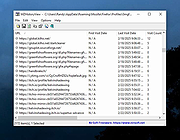 |
|
| Old Layout for Facebook v6.6 Old Layout for Facebook v6.6 Revert Facebook to the Old Layout (pre-Sep 2020) by changing your browser's user-agent string to one not supported by the new layout. Don't like the new Facebook layout? Been forced into it with no option to go back? No worries! Old Layout for Facebook forces the site to display the old layout, rather than the new. Simple install - no options to configure Easy to uninstall if you change your mind This download is for the Firefox extension. If you need the Chrome extension, download here. If you need the Opera extension, download here. If you need the Edge Chromium extension, download here. Click here to visit the author's website. |
 |
3,160 | Nov 02, 2020 Matt Kruse 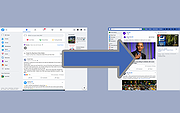 |
|
| security.txt v1.1.0 security.txt v1.1.0 A cross-platform browser extension for displaying security.txt and humans.txt files. How does it work? As you browse the web and navigate to different websites, the browser extension checks the website to see if it supports either type of file. If it does, an icon is shown in the URL bar. You can click this icon to view more details about the text files that were located. What is security.txt? security.txt is a proposed standard that provides a means for websites and software authors to define their security policies. This is useful to security researchers or anyone who would like to responsibly disclose a vulnerability to the owners of the website or software. What is humans.txt? humans.txt is a less formal initiative for providing human-readable information about the authors of the website. Where to get it: This download is the Firefox extension. To get it for other browsers, choose below: Chrome and Chromium Install from the Chrome Web Store Microsoft Edge Install from the Microsoft Edge Addon Store Install From Source Source is available on Github Click here to visit the author's website. |
 |
3,760 | Dec 17, 2020 Harmless Systems 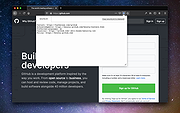 |
|
| SeoQuake v3.9.9 SeoQuake v3.9.9 A Powerful SEO Toolbox for your Browser Check any webpage for a huge selection of SEO parameters on the fly, with the free SEOquake browser extension. Conduct on-page SEO audit in a flash Examine internal and external links Compare domains and URLs in real time Export all data into a file INTRODUCTION SEOquake is a free plugin for your browser that provides you with organic research data at the click of a button. Currently compatible with Mozilla Firefox, Google Chrome and Opera, SEOquake can provide parameters for listings within search engine results. Along with organic research data, SEOquake provides other useful tools including an SEO Audit, Keyword Density report, Internal/External Link analysis and even social metrics. Many people try to find information out on their competitors by analyzing SERPs and determining who is ranking where. You search a particular keyword and analyze the results that show up. You then receive these results and have to manually retrieve the information for each landing page that shows up. But what if you could receive all of the analytical data needed for each landing page or domain straight from the SERP itself? What if you could remove countless hours spent on manually retrieving this data all at the click of a button? Here is where SEOquake comes in! This free plugin allows you to see metrics for domains and landing pages including Google Index, Alexa Rank, SEMrush Ranking data, Facebook likes and much more. These metrics are all available to be shown directly from the SERPs so that you understand where each domain and landing page being displayed stand amongst each other. SEOquake gives you quick and easy access to analytical data on any webpage. By using our SEObar, you can navigate to any landing ... |
 |
2,807 | Sep 14, 2023 SeoQuake Team 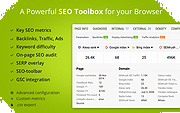 |
|
| StorURL v3.0.35.0 StorURL v3.0.35.0 A bookmark manager that helps you to store links to all of your favorite websites in one central repository. It works with the browsers installed on your system so you can open your links in any web browser you’d like from one central interface. Import your bookmarks from most major browsers, including Google Chrome, Mozilla Firefox, Internet Explorer and Opera. Open websites in any browser installed on your computer, directly from within StorURL. Store and sort sites in unlimited categories. Enable a floating toolbar that you can keep anywhere on your screen, for quick access to all your bookmarks. Generate HTML “home” pages containing links from one or all categories. Supported/Tested Operating Systems Windows 7, Windows 8, Windows 8.1, Windows 10, Windows 11 Changes: 3.0.35.0 (Released: 2021-10-03) fixed bug where using the "Override system default browser" also overrode individual default browsers fixed bug where the Open URL button on the main toolbar ignored all specified browsers and launched the system default fixed mnemonic underlining in the Site Information panel fixed help browser so external links open in your system's default browser, instead of IE updated some documentation to be more clear about scanning URLs Prerequisites The following items are required for StorURL to run properly. .NET 3.5 TLS 1.2 support (Win 7 details) (broken links) .NET 3.5 TLS 1.2 support (Win7 32-bit) (direct download) .NET 3.5 TLS 1.2 support (Win7 64-bit) (direct download) .NET 3.5 TLS 1.2 support (Win8/10) .NET Framework Microsoft Visual C++ 2005 Service Pack 1 Redistributable Package MFC ... |
 |
5,522 | Oct 04, 2021 HazteK Software 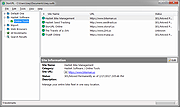 |
|
| WebCacheImageInfo v1.35 WebCacheImageInfo v1.35 Display images information stored in Web browser cache. WebCacheImageInfo is a simple tool that searches for JPEG images with EXIF information stored inside the cache of your Web browser (Internet Explorer, Firefox, or Chrome), and then it displays the list of all images found in the cache with the interesting information stored in them, like the software that was used to create the image, the camera model that was used to photograph the image, and the date/time that the image was created. System Requirements And Limitations • This utility works in any version of Windows, starting from Windows XP and up to Windows 11. Both 32-bit and 64-bit systems are supported. • The following Web browsers are supported: Internet Explorer, Mozilla Firefox, SeaMonkey, and Google Chrome. Opera is not supported because it stores the JPEG images in Webp format. • WebCacheImageInfo won't work if you configure your Web browser to clear the cache after closing it. • It's recommended to close all windows of your Web browser before using WebCacheImageInfo, to ensure that all cache files are saved to the disk. • Be aware that WebCacheImageInfo only displays JPEG images with EXIF information stored in them. It doesn't display other images stored in the cache of your Web browsers. Changes: v1.35: Updated to read the cache files of the latest Chrome version. Start Using WebCacheImageInfo WebCacheImageInfo doesn't require any installation process or additional DLL files. In order to start using it, simply run the executable file - WebCacheImageInfo.exe After running it, WebCacheImageInfo begins to scan the cache of your Web browser and displays every JPEG image with EXIF information found inside the cache. You may need to wait up to a few ... |
 |
8,842 | Oct 03, 2024 Nir Sofer  |
|
| Showing rows 1 to 25 of 25 | Showing Page 1 of 1 | 1 |
OlderGeeks.com Copyright (c) 2025